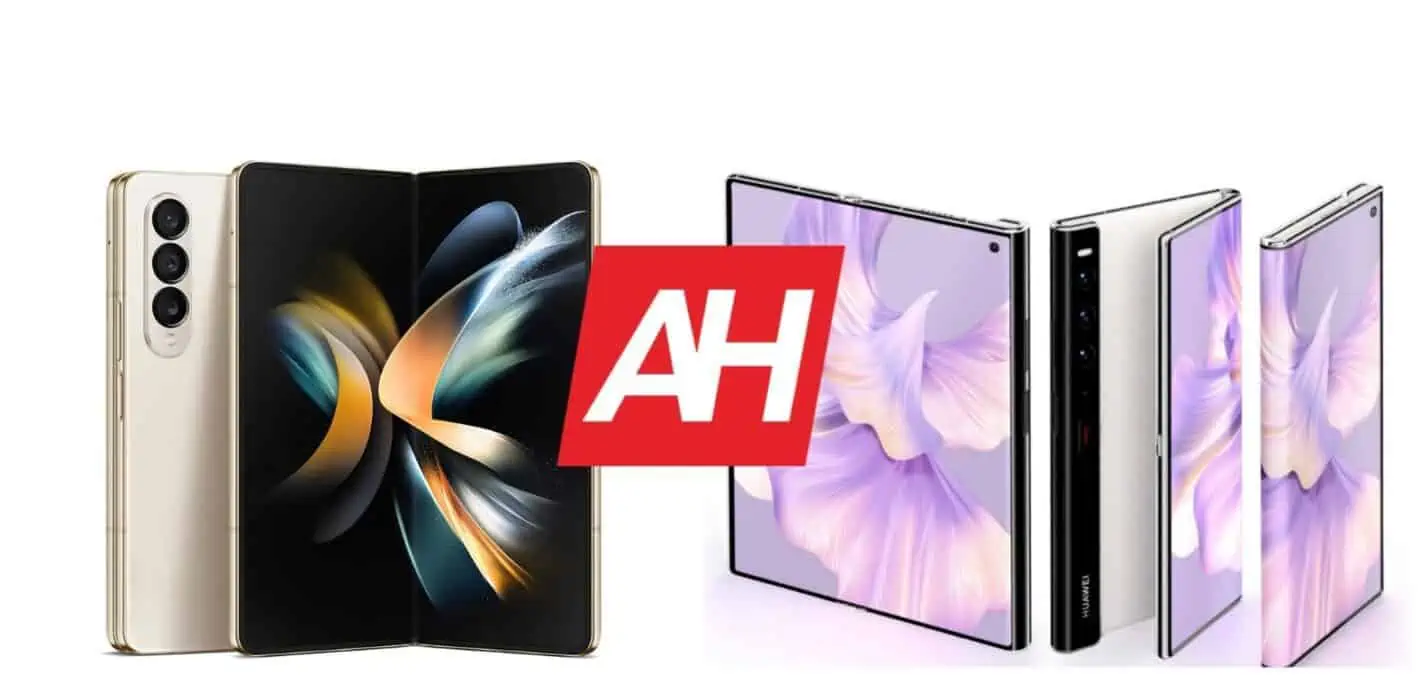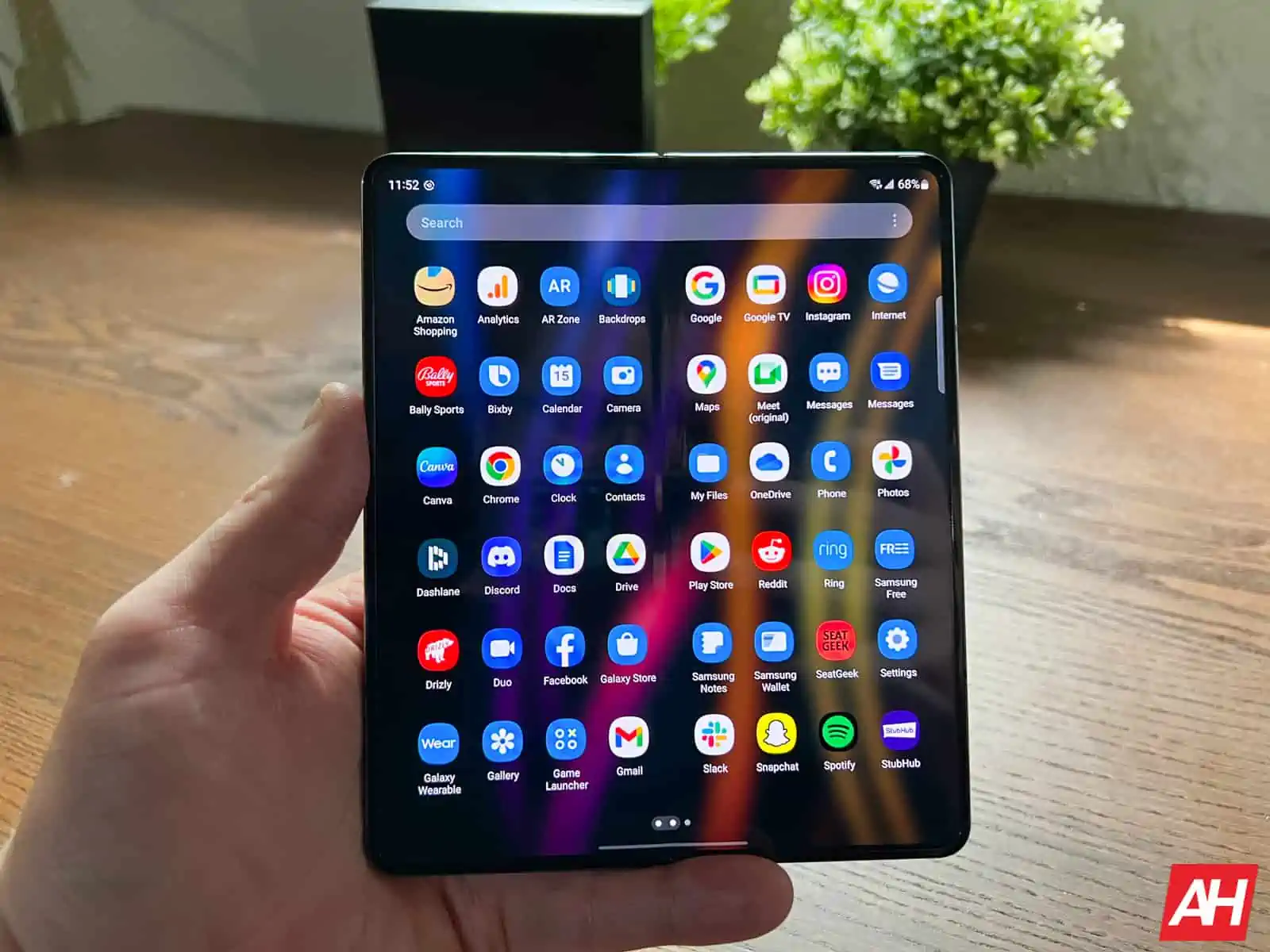In this article, we’ll check out two really compelling foldables from Samsung and Huawei. These two devices are both quite large, but they’re considerably different at the same time. We’ll compare the Samsung Galaxy Z Fold 4 vs Huawei Mate Xs 2. The former folds inwards, while the latter folds outwards, even though they both fold vertically. There is a lot to talk about here, and you may even be surprised by some differences, mainly in the design department.
The Galaxy Z Fold 4 got announced earlier this month, while the Mate Xs 2 launched earlier this year. The Mate Xs 2 did take its time to reach global markets, though. That being said, we’ll first list their specifications, and will then move to other categories. We’ll compare their designs, displays, performance, battery life, cameras, and audio performance. This article will hopefully be able to help you make a purchasing decision.
Before you do, though, do note that the Huawei Mate Xs 2 comes without Google services, and that it’s not available in as many markets as the Galaxy Z Fold 4. That being said, let’s get started, shall we?
Specs
| Samsung Galaxy Z Fold 4 | Huawei Mate Xs 2 | |
| Screen size | Main: 7.6-inch fullHD+ Dynamic AMOLED 2X display (foldable, 120Hz) Secondary (Cover): 6.2-inch HD+ Dynamic AMOLED 2X display (flat, 120Hz) |
Main: 7.08-inch QHD+ Foldable OLED display (foldable, 120Hz) Secondary (Cover): 6.5-inch fullHD+ OLED display (flat, 120Hz) |
| Screen resolution | Main: 2176 x 1812 Secondary (Cover): 2316 x 904 |
Main: 2480 x 2200 Secondary (Cover): 2480 x 1176 |
| SoC | Qualcomm Snapdragon 8+ Gen 1 | Qualcomm Snapdragon 888 |
| RAM | 12GB (LPDDR5) | 8GB (LPDDR5) |
| Storage | 256GB/512GB/1TB (UFS 3.1), non-expandable | 512GB; expandable (up to 256GB) |
| Rear cameras | 50MP (f/1.8 aperture, 24mm lens, 1.0um pixel size, Dual Pixel PDAF, OIS) 10MP (telephoto, f/2.4 aperture, 67mm lens, 1.0um pixel size, PDAF, OIS, 3x optical zoom) 12MP (f/2.2 aperture, 123-degree FoV, 12mm lens, 1.12um pixel size) |
50MP (f/1.8 aperture, Laser AF, PDAF) 8MP (f/2.4 aperture, OIS, PDAF, 3x optical zoom) 13MP (f/2.2 aperture, 120-degree FoV) |
| Front cameras | Main: 4MP (f/1.8 aperture, 26mm lens, 2.0um pixel size, under-display) Secondary: 10MP (f/2.2 aperture, 24mm lens, 1.22um pixel size) |
10.7MP (f/2.2 aperture) |
| Battery | 4,400mAh, non-removable, 25W wired charging, 15W wireless charging, 4.5W Wireless PowerShare | 4,600mAh, non-removable, 66W wired charging, reverse wired charging |
| Dimensions | Unfolded: 155.1 x 130.1 x 6.3mm Folded: 155.1 x 67.1 x 15.8mm |
Unfolded: 156.5 x 139.9 x 5.4mm Folded: 156.5 x 75.5 x 11.1mm |
| Weight | 263 grams | 255 grams |
| Connectivity | 5G, LTE, NFC, Bluetooth 5.2, Wi-Fi, USB Type-C | 4G, LTE, NFC, Bluetooth 5.2, Wi-Fi, USB Type-C |
| Security | Side-facing fingerprint scanner | Side-facing fingerprint scanner |
| OS | Android 12 One UI 4.1.1 |
Android 11 EMUI 12 |
| Price | $1,799 | €1,999 |
| Buy | Samsung | Huawei |
Samsung Galaxy Z Fold 4 vs Huawei Mate Xs 2: Design
Both of these devices are quite large in the general sense, but they are also quite different at the same time. The Huawei Mate Xs 2 is considerably thinner than the Galaxy Z Fold 4. It’s thinner even when unfolded, but its thinness fully shines when the phone is folded. It’s only 11.1mm thick when folded, compared to 14.2-15.8mm of the Galaxy Z Fold 4. It also sits fully flush when folded, unlike the Galaxy Z Fold 4.
The Huawei Mate Xs 2 also feels like a regular smartphone with pronounced curves when folded. That’s not the case with the Galaxy Z Fold 4. This design does have its downsides, though, of course. When folded, almost half of the display is exposed on the back, so not using a case is a bad idea. The folding also feels smoother on the Galaxy Z Fold 4, as there’s not that satisfying snap into place on the Huawei Mate Xs 2. It also requires more force to fold the Mate Xs 2.
Both devices have thin bezels, though the Mate Xs 2’s definitely seem thinner, and its curves only help the matter. The Galaxy Z Fold 4 includes two displays, while the Mate Xs 2 has one. Half of it goes dormant when the phone is folded. The two phones are similar in terms of height, while the Mate Xs 2 is wider when both folded and unfolded. It’s actually a lot wider when folded. The Galaxy Z Fold 4 is a bit heavier than the Mate Xs 2.
Both devices are fairly slippery, while the Galaxy Z Fold 4 offers IPX8 certification for water resistance. The same cannot be said for the Huawei Mate Xs 2. So, as you can see, these two phones are fairly different design-wise. They have entirely different approaches to design, though both are quite compelling.
Samsung Galaxy Z Fold 4 vs Huawei Mate Xs 2: Display
The Galaxy Z Fold 4 comes with two displays, while the Huawei Mate Xs 2 has one. The thing is, when folded, the Huawei Mate Xs 2’s display gets smaller, as part of its display shuts down. The Galaxy Z Fold 4 features a 7.6-inch 2176 x 1812 Foldable Dynamic AMOLED 2X display. That display offers a 120Hz refresh rate, gets up to 1,200 nits of brightness, and offers HDR10+ support.
The phone’s cover display measures 6.2 inches. It offers a resolution of 2316 x 904, and that is also a Dynamic AMOLED 2X panel. This display also offers a 120Hz refresh rate, and it’s protected by the Gorilla Glass Victus+. Both displays on the device are flat, by the way. The cover display includes a centered display camera hole, while the main one has an under-display camera.
Huawei’s foldable, on the other hand, includes a 7.8-inch 2480 x 2200 Foldable OLED display. That is a 120Hz display, which can show up to 1 billion colors. When folded, you end up with a 6.5-inch OLED display with a resolution of 2480 x 1176. Needless to say, you’re still left with a 120Hz panel here, as we’re talking about the same display, but only a part of it remains active after it gets folded.
In case you’re wondering if these displays are any good, well yes, they are. You end up with sharp, bright, and vivid displays, regardless of which one we check out. Samsung does have an advantage in the brightness department, but you can’t go wrong with either one.
Samsung Galaxy Z Fold 4 vs Huawei Mate Xs 2: Performance
Both of these phones are flagship-grade phones, so they’re quite powerful. The Galaxy Z Fold 4 does technically have more powerful specs, though. The Huawei Mate Xs 2 is using the Snapdragon 888, which is Qualcomm’s flagship for last year. That chip is also limited to 4G connectivity on the phone, and all that because of the US sanctions. The Galaxy Z Fold 4, on the other hand, utilizes the Snapdragon 8+ Gen 1 processor, the latest and greatest Qualcomm has to offer.
The Galaxy Z Fold 4 comes with 12GB of LPPDR5 RAM, and UFS 3.1 flash storage. The Huawei Mate Xs 2 sports either 8GB or 12GB of LPDDR5 RAM and UFS 3.1 flash storage. Do these specs translate to good performance? Well yes, they do. Despite the fact the Mate Xs 2 has an older SoC, it’s keeping up with the Galaxy Z Fold 4 in the performance department. The Snapdragon 888 is still extremely powerful, so that’s not surprising.
Neither phone gets too hot during use, though they do get warm if you’re intensively gaming. You will notice a stutter from time to time, on both phones, but we didn’t really notice any lag worth noting. They both run really nicely, regardless of what you’re doing. Once again, do note that the Huawei Mate Xs 2 comes without Google services. It includes Huawei’s HMS, and the company’s own app store. If that’s not a problem for you, you’ll be more than happy with the performance on either phone.
Samsung Galaxy Z Fold 4 vs Huawei Mate Xs 2: Battery
The Galaxy Z Fold 4 comes with a 4,400mAh battery, while the global variant of the Mate Xs 2 includes a 4,600mAh battery. That’s the only configuration for global markets, but in China, there’s also a 4,880mAh model, in addition to a 4,600mAh one. In any case, do note that we used the global variant of the phone, so we’re talking about a model of the device with a 4,600mAh battery.
Having said that, let’s start with the Galaxy Z Fold 4. The battery life on the device doesn’t seem to be all that great. We were able to get to 6 hours of screen-on-time, but not regularly. It was actually closer to 4-5 hours of screen-on-time with our usage. That did not include much gaming, by the way. It did, however, include taking pictures, using Google Maps, web browsing, sending emails, using TikTok, and so on. So, the battery life wasn’t really that great.
How about the Huawei Mate Xs 2? Well, it didn’t impress in the battery life department either. With similar usage to the Galaxy Z Fold 4, it performed even worse. So neither of these two foldables offers amazing battery life, at least in our experience.
What about charging, though? Well, the Galaxy Z Fold 4 supports 25W wired charging, while the Huawei Mate Xs 2 offers support for 66W wired charging. Do note that the Mate Xs 2 does come with a charging brick, while the Galaxy Z Fold 4 does not. The Galaxy Z Fold 4 does support 15W wireless charging, though, and also 4.5W reverse wireless charging. The Mate Xs does not offer support for wireless charging, but it does support reverse wired charging.
Samsung Galaxy Z Fold 4 vs Huawei Mate Xs 2: Cameras
Both of these phones come with three cameras on the back. The Galaxy Z Fold 4 utilizes a 50-megapixel main camera, backed by a 10-megapixel telephoto unit, and a 12-megapixel ultrawide camera. The Huawei Mate Xs 2 utilizes a 50-megapixel main unit, along with an 8-megapixel telephoto camera, and a 13-megapixel ultrawide unit. Both sets of cameras do a really good job, actually.
Even for those more demanding amongst you, these two camera setups should be enough. The Galaxy Z Fold 4 generally takes more vibrant shots, while the Huawei Mate Xs 2 is more color-accurate. That is especially noticeable during the day, and especially outdoors. Both phones provide truly detailed shots, with basically no noise, speaking of daily shots. In low light, both do a great job, but the Mate Xs 2 may even have an upper hand here. It takes shots really fast, and there’s virtually no difference between shots in regular mode and night mode. Both phones keep details in check in such conditions.
Ultrawide cameras are also really good, though once again, the Mate Xs 2 probably does a slightly better job in low light. The results are more than comparable, though. The Galaxy Z Fold 4’s telephoto camera takes the cake though, in all conditions.
Audio
If you were hoping that at least one of these two phones has an audio jack, well, we’re sorry to disappoint you. You’ll have to rely on the Type-C port at the bottom of each phone, or on a wireless connection via Bluetooth.
Speaking of which, both devices offer Bluetooth 5.2 They both have stereo speakers as well, and those speakers do a great job. Samsung’s are tuned by AKG, and they do have a different sound profile. Both sets of speakers get loud enough, and are quite sharp.



